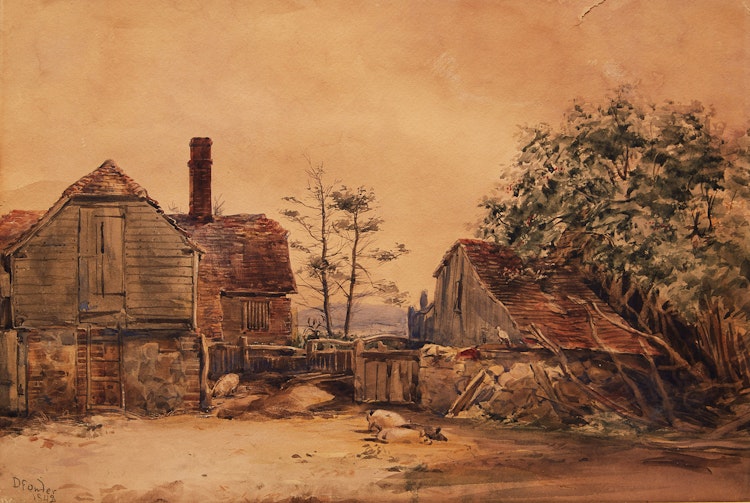Farm Scene by Daniel Fowler

Daniel Fowler
Farm Scene
watercolour
signed and dated 1842 lower left
12.5 x 18.75 ins ( 31.8 x 47.6 cms ) ( sight )
Auction Estimate: $500.00 - $700.00
Price Realized $2,640.00
Sale date: December 14th 2021
Sotheby’s, auction, November 1-3, 1971, Lot 158
Private Collection, Ontario
Share this item with your friends
Daniel Fowler
(1810 - 1894)
Born in Down, Kent, England, he showed an early liking for art, although he did not receive encouragement from his parents, who had hopes of him becoming a lawyer. As a boy, he attended a commercial school in Camberwell, London, and later the Unitarian school at Walthamstow, where he received a good classical training and showed an aptitude in mathematics. He spent many hours in the school library and much time at drawing, which was his favourite occupation. At the age of 16, he was articled in the Doctors’ Commons, an association of Doctors of Laws, founded in 1511. Fowler found this field uninteresting and after his father died, he turned to art. A local artist encouraged him and he entered the studio of James Duffield Harding, who was a much-esteemed landscape painter. (Much later, however, Fowler realized that Harding’s training had deprived him of development with colour). At the age of 24, Fowler took a walking tour through Europe and spent much time in Switzerland, Italy, and cities of the Rhine and Moselle districts. In Rome, he almost died of smallpox and returned to England. In London once more, he married and settled as a professional water colourist. His health broke down. His physician advised him to change his surroundings and Fowler left with his wife and children for Upper Canada, where he settled at Amherst Island after a brief tour of the western part of the province.
During his 14 years in Canada, Fowler didn’t paint, but spent all his time farming his land and maintaining his home, which he named “The Cedars”. In the fourteenth year of his new settlement, his home burned to the ground and he lost all his belongings, including precious family heirlooms. He rebuilt his house and went to England in 1857. There, his interest in art was revived and on his return to Canada, he took up painting again. His first works were small and experimental and were mainly drawings which he managed to do during his free moments between farm chores. He returned to England in 1859 with these drawings but they were unnoticed probably because of their lack of colour. On his return to Canada, he continued to farm and to develop his sketches, specializing in still lifes. His water colours became colourful, unlike his earlier dull browns and greys, which shared an affinity with Harding’s, although Harding’s work, to quote Newton MacTavish, “… had fine qualities of structure and a technical skill in the depiction and suggestion of tree growth and character….” According to an intimate friend, Fowler never allowed anyone to watch him while he worked; however, this is not uncommon among artists. In 1863, he began to exhibit his first paintings and took first prize at the Provincial Exhibition at Kingston.
He then sent his works to Toronto. It was about this time that a Toronto painter and musician, a Mr. Gilbert, took an interest in Fowler’s work and became his art dealer. As Fowler’s reputation grew, he also achieved recognition at exhibitions, including his most important single honour received in 1876 at the Centennial Exhibition in Philadelphia, when the only prize awarded to Canada for water colour work was given to him for his “Hollyshocks”. This was a painting which Fowler had completed in 1869, which the National Gallery of Canada acquired for their collection as well as examples of his landscapes, dead game, and one entitled “Fisher Boys of Hastings”.
Fowler found most of his subject matter around his own farm. In 1872, he was elected a founding member of the Ontario Society of Artists. As his growing sons took more of the responsibility around the farm, he was left with more time for painting. In 1880, he became a founding member of the Royal Canadian Academy and continued his activity as a painter until he died. He began writing his autobiography in 1894, when he was 84 years old, a typed copy of which became the possession of his granddaughters Miss Edna L. Fowler and Mrs. Florence A. Howard at Napanee, Ontario. The original handwritten manuscript is owned by another descendant who was last reported to be living in “The Cedars” on Amherst Island. Canadian art historian Thomas R. Lee visited Fowler’s old home and obtained extracts from the artist’s autobiography, which he published in pamphlet form under the auspices of the Ontario Historical Society.
Daniel Fowler died at the age of 84 in 1894 and was buried in the cemetery on Amherst Island.
Literature Source:
"A Dictionary of Canadian Artists, Volume 1: A-F, 5th Edition, Revised and Expanded", compiled by Colin S. MacDonald, Canadian Paperbacks Publishing Ltd, Ottawa, 1997

